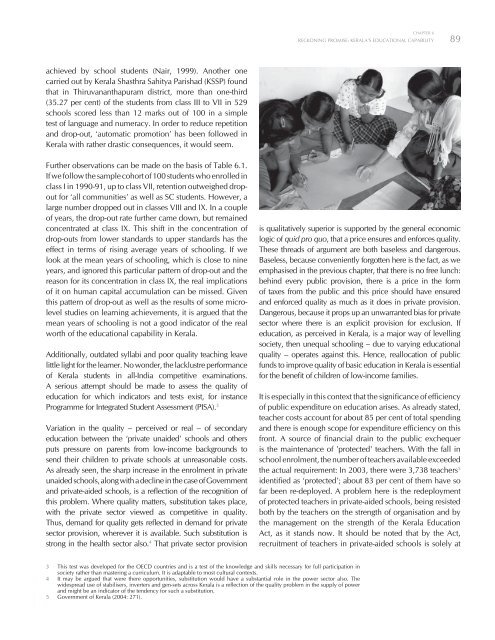Kerala 2005 - of Planning Commission
Kerala 2005 - of Planning Commission
Kerala 2005 - of Planning Commission
Create successful ePaper yourself
Turn your PDF publications into a flip-book with our unique Google optimized e-Paper software.
CHAPTER 6<br />
RECKONING PROMISE: KERALA’S EDUCATIONAL CAPABILITY<br />
89<br />
achieved by school students (Nair, 1999). Another one<br />
carried out by <strong>Kerala</strong> Shasthra Sahitya Parishad (KSSP) found<br />
that in Thiruvananthapuram district, more than one-third<br />
(35.27 per cent) <strong>of</strong> the students from class III to VII in 529<br />
schools scored less than 12 marks out <strong>of</strong> 100 in a simple<br />
test <strong>of</strong> language and numeracy. In order to reduce repetition<br />
and drop-out, ‘automatic promotion’ has been followed in<br />
<strong>Kerala</strong> with rather drastic consequences, it would seem.<br />
Further observations can be made on the basis <strong>of</strong> Table 6.1.<br />
If we follow the sample cohort <strong>of</strong> 100 students who enrolled in<br />
class I in 1990-91, up to class VII, retention outweighed dropout<br />
for ‘all communities’ as well as SC students. However, a<br />
large number dropped out in classes VIII and IX. In a couple<br />
<strong>of</strong> years, the drop-out rate further came down, but remained<br />
concentrated at class IX. This shift in the concentration <strong>of</strong><br />
drop-outs from lower standards to upper standards has the<br />
effect in terms <strong>of</strong> rising average years <strong>of</strong> schooling. If we<br />
look at the mean years <strong>of</strong> schooling, which is close to nine<br />
years, and ignored this particular pattern <strong>of</strong> drop-out and the<br />
reason for its concentration in class IX, the real implications<br />
<strong>of</strong> it on human capital accumulation can be missed. Given<br />
this pattern <strong>of</strong> drop-out as well as the results <strong>of</strong> some microlevel<br />
studies on learning achievements, it is argued that the<br />
mean years <strong>of</strong> schooling is not a good indicator <strong>of</strong> the real<br />
worth <strong>of</strong> the educational capability in <strong>Kerala</strong>.<br />
Additionally, outdated syllabi and poor quality teaching leave<br />
little light for the learner. No wonder, the lacklustre performance<br />
<strong>of</strong> <strong>Kerala</strong> students in all-India competitive examinations.<br />
A serious attempt should be made to assess the quality <strong>of</strong><br />
education for which indicators and tests exist, for instance<br />
Programme for Integrated Student Assessment (PISA). 3<br />
Variation in the quality – perceived or real – <strong>of</strong> secondary<br />
education between the ‘private unaided’ schools and others<br />
puts pressure on parents from low-income backgrounds to<br />
send their children to private schools at unreasonable costs.<br />
As already seen, the sharp increase in the enrolment in private<br />
unaided schools, along with a decline in the case <strong>of</strong> Government<br />
and private-aided schools, is a reflection <strong>of</strong> the recognition <strong>of</strong><br />
this problem. Where quality matters, substitution takes place,<br />
with the private sector viewed as competitive in quality.<br />
Thus, demand for quality gets reflected in demand for private<br />
sector provision, wherever it is available. Such substitution is<br />
strong in the health sector also. 4 That private sector provision<br />
is qualitatively superior is supported by the general economic<br />
logic <strong>of</strong> quid pro quo, that a price ensures and enforces quality.<br />
These threads <strong>of</strong> argument are both baseless and dangerous.<br />
Baseless, because conveniently forgotten here is the fact, as we<br />
emphasised in the previous chapter, that there is no free lunch:<br />
behind every public provision, there is a price in the form<br />
<strong>of</strong> taxes from the public and this price should have ensured<br />
and enforced quality as much as it does in private provision.<br />
Dangerous, because it props up an unwarranted bias for private<br />
sector where there is an explicit provision for exclusion. If<br />
education, as perceived in <strong>Kerala</strong>, is a major way <strong>of</strong> levelling<br />
society, then unequal schooling – due to varying educational<br />
quality – operates against this. Hence, reallocation <strong>of</strong> public<br />
funds to improve quality <strong>of</strong> basic education in <strong>Kerala</strong> is essential<br />
for the benefit <strong>of</strong> children <strong>of</strong> low-income families.<br />
It is especially in this context that the significance <strong>of</strong> efficiency<br />
<strong>of</strong> public expenditure on education arises. As already stated,<br />
teacher costs account for about 85 per cent <strong>of</strong> total spending<br />
and there is enough scope for expenditure efficiency on this<br />
front. A source <strong>of</strong> financial drain to the public exchequer<br />
is the maintenance <strong>of</strong> 'protected' teachers. With the fall in<br />
school enrolment, the number <strong>of</strong> teachers available exceeded<br />
the actual requirement: In 2003, there were 3,738 teachers 5<br />
identified as ‘protected’; about 83 per cent <strong>of</strong> them have so<br />
far been re-deployed. A problem here is the redeployment<br />
<strong>of</strong> protected teachers in private-aided schools, being resisted<br />
both by the teachers on the strength <strong>of</strong> organisation and by<br />
the management on the strength <strong>of</strong> the <strong>Kerala</strong> Education<br />
Act, as it stands now. It should be noted that by the Act,<br />
recruitment <strong>of</strong> teachers in private-aided schools is solely at<br />
3 This test was developed for the OECD countries and is a test <strong>of</strong> the knowledge and skills necessary for full participation in<br />
society rather than mastering a curriculum. It is adaptable to most cultural contexts.<br />
4 It may be argued that were there opportunities, substitution would have a substantial role in the power sector also. The<br />
widespread use <strong>of</strong> stabilisers, inverters and gen-sets across <strong>Kerala</strong> is a reflection <strong>of</strong> the quality problem in the supply <strong>of</strong> power<br />
and might be an indicator <strong>of</strong> the tendency for such a substitution.<br />
5 Government <strong>of</strong> <strong>Kerala</strong> (2004: 271).

















